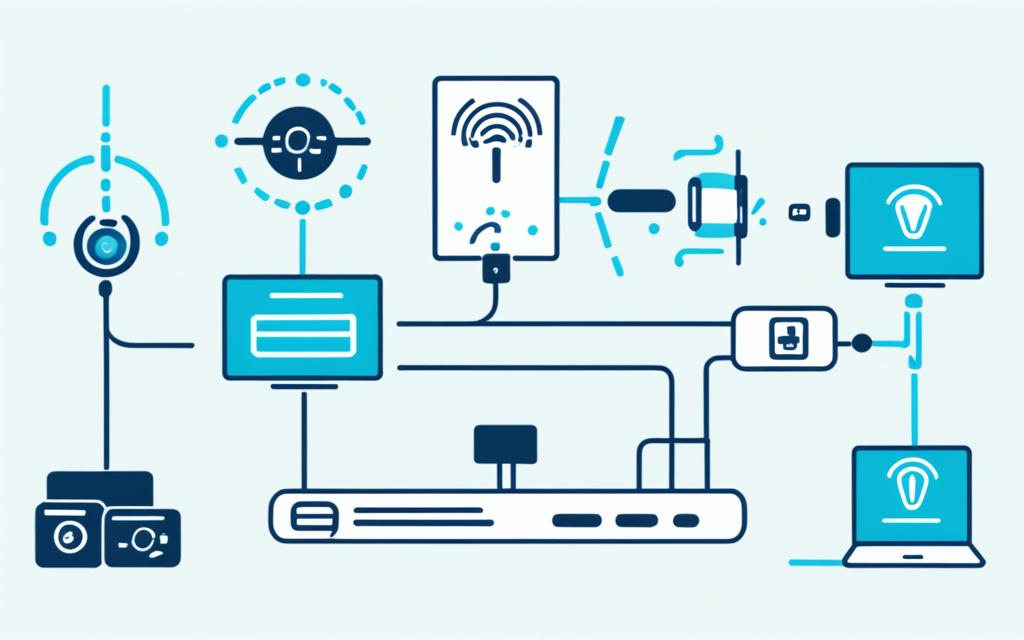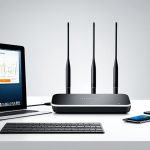A personal area network (PAN) is a network that interconnects electronic devices within the range of a single user, typically around 10 meters or 33 feet. PANs can be wired or wireless and are designed to facilitate communication and resource sharing among devices in small office or home office (SOHO) environments. PANs commonly consist of devices such as laptops, smartphones, tablets, wearables, printers, and entertainment devices. The concept of PAN was first developed by researchers at MIT’s Media Lab and supported by IBM’s Almaden research lab.
Types of PANs
Personal Area Networks (PAN) can be classified into two main types: wireless PANs (WPANs) and wired PANs. Each type utilizes different technologies to facilitate communication and connectivity.
Wireless PANs (WPANs)
Wireless PANs are designed to serve a single user, small office or home office (SOHO), or a small workgroup. They make use of low-powered, short-distance wireless network technologies to establish connections between devices within a limited range. Some of the commonly used wireless PAN technologies include:
- Infrared Data Association (IrDA): IrDA utilizes infrared light to transmit data between devices. It is commonly found in remote controls, laptops, and other devices.
- Wireless Universal Serial Bus (USB): Wireless USB technology enables wireless connectivity between devices, eliminating the need for physical USB cables.
- Bluetooth: Bluetooth technology allows for short-range wireless communication between devices, such as smartphones, tablets, and wireless headphones.
- Ultra Wideband (UWB): UWB technology enables high-speed data transfer over short distances, making it suitable for applications like wireless streaming and file sharing.
- Zigbee: Zigbee is a low-power wireless communication technology that supports the connection of devices in industrial, home automation, and healthcare applications.
Wired PANs
On the other hand, wired PANs utilize wired technologies to establish connections between devices within a limited distance. These technologies provide secure and reliable connections for short-range communication. Some examples of wired PAN technologies are:
- USB (Universal Serial Bus): USB is a widely used wired technology for connecting various peripherals, such as printers, keyboards, and mice, to a computer or other devices.
- IEEE 1394 (FireWire): IEEE 1394, also known as FireWire or i.Link, is a high-performance serial bus used for connecting devices like digital cameras, external hard drives, and audio equipment.
- Thunderbolt: Thunderbolt is a high-speed wired technology that allows for fast data transfer and daisy-chaining of devices. It is commonly used in professional audio, video, and storage applications.
These wired PAN technologies provide reliable and efficient connections between devices, making them suitable for specific applications that require high data transfer rates or specialized functionalities.
Common use cases for a PAN
PANs have various applications and use cases. They provide a wide range of possibilities, enabling individuals and small workgroups to enhance their connectivity and productivity. Let’s explore some common use cases for PANs.
1. Body Area Network
A body area network (BAN) is a wireless network that moves with a person, allowing for seamless communication within their immediate proximity. BANs can be established by connecting devices like smartphones and Bluetooth headphones, enabling individuals to stay connected while on the go. This application is particularly useful in industries such as healthcare, where medical devices can be wirelessly connected to monitor patients’ vital signs and ensure prompt medical assistance.
2. Wearable Technology
Wearable technology has gained significant popularity in recent years, and PANs play a crucial role in enabling seamless integration and data exchange among these devices. Devices like smart clothing and smart watches equipped with accelerometers can monitor individuals’ daily activities and exchange information. For example, a fitness tracker can sync data with a smartphone or computer, providing users with insights into their health and fitness progress.
3. Offline Network in Homes
In a world where smart homes are becoming increasingly common, PANs are used to create offline networks within residential settings. This allows devices like printers, TVs, game systems, laptops, and other home appliances to be interconnected, enabling seamless communication and resource sharing. For instance, users can print documents wirelessly from their laptop to a printer located in another room in the house.
4. Home Office
With the rise of remote work and the home office trend, PANs play a vital role in providing a separate network for work purposes. This helps maintain a secure and efficient workflow, separate from the rest of the home network. Users can connect their work devices, such as laptops, printers, and scanners, to the PAN, enabling seamless communication and collaboration.
These are just a few examples of the diverse applications and use cases for PANs. As technology continues to advance, it is expected that PANs will find new and innovative ways to enhance connectivity and improve efficiency in various domains.
Difference between a PAN and a LAN
Although Personal Area Networks (PANs) and Local Area Networks (LANs) are both types of computer networks, they have distinct characteristics and uses. Understanding the differences between them can help users determine which network is most suitable for their needs.
PAN: Personal Area Network
A PAN is a network that connects devices within the short range of an individual person, typically around 10 meters or 33 feet. It serves as a network for personal devices in close proximity, such as smartphones, tablets, laptops, wearables, and appliances. PANs are commonly used in home automation for low data-rate applications.
LAN: Local Area Network
A LAN, on the other hand, connects devices at a single site, usually within an office building or a school campus. It provides networking capabilities for multiple users within a specific location, enabling high-speed data transmission and resource sharing. LANs are designed for larger-scale applications that require extensive network coverage.
Differences in Network Scope and Range
The primary difference between a PAN and a LAN lies in their network scope and range. A PAN is limited to the immediate surroundings of an individual, typically within a home or a small office. In contrast, a LAN covers a larger area, such as an office building or a campus, allowing connectivity and collaboration across multiple rooms or departments.
Applications and Device Connectivity
In terms of applications, PANs are typically used for personal device connectivity and home automation. They facilitate easy communication and resource sharing between devices within close proximity. On the other hand, LANs are designed for broader applications, such as enterprise networking, educational institutions, and public Wi-Fi zones. LANs enable seamless connectivity for a large number of devices, including computers, servers, printers, and other network-enabled devices.
Data Transmission Rates
Another significant difference is the data transmission rates. PANs are optimized for low data-rate applications, focusing on efficient connectivity for personal devices. LANs, on the other hand, are designed for high-speed and high-bandwidth data transmission. They provide the necessary infrastructure for sharing large volumes of data among multiple users simultaneously.
Summary of Differences
Here is a summary of the key differences between PANs and LANs:
| Personal Area Network (PAN) | Local Area Network (LAN) |
|---|---|
| Connects devices within 10 meters | Connects devices at a single site or location |
| Mainly used for personal device connectivity and home automation | Designed for larger-scale applications and enterprise networking |
| Optimized for low data-rate applications | Designed for high-speed and high-bandwidth data transmission |

In conclusion, while PANs and LANs are both computer networks, they serve different purposes and operate on different scales. PANs are best suited for personal device connectivity within a short range, ideal for home automation and personal applications. LANs, on the other hand, are designed for larger-scale connectivity, serving multiple users within a specific site or location. By understanding their differences, users can choose the appropriate network for their specific needs.
Advantages of PANs
PANs offer several advantages that make them a valuable choice for connecting devices within a limited range. These advantages include:
- Wireless Connectivity: PANs eliminate the need for wires, enabling devices to connect wirelessly. Technologies like Bluetooth facilitate seamless wireless communication between devices, enhancing convenience and reducing clutter.
- Easy Setup: Setting up a PAN is a straightforward process. With wireless connectivity, users can easily pair devices and establish connections without the hassle of dealing with cables and complex configurations.
- Data Synchronization: PANs enable seamless data synchronization between devices. This means users can effortlessly exchange, download, and upload data across their interconnected devices, ensuring data consistency and accessibility.
- Portability: One of the key advantages of PANs is their portability. Users can easily carry their devices and maintain connectivity wherever they go, allowing for flexible data exchange and communication.
By harnessing these advantages, PANs offer users a convenient, wire-free, and efficient solution for connecting devices and facilitating seamless communication and data sharing.
Wireless Connectivity:
| Advantage | Description |
|---|---|
| Wireless Connectivity | PANs eliminate the need for wires and enable devices to connect wirelessly using technologies like Bluetooth. |
| Easy Setup | PANs provide a hassle-free setup process without the need for complex configurations and cable connections. |
| Data Synchronization | PANs allow for seamless data synchronization between devices, ensuring consistent and accessible data exchange. |
| Portability | PANs offer high portability, allowing users to carry devices and exchange data wherever they go. |
Disadvantages of PANs
Despite the many advantages that Personal Area Networks (PANs) offer, they also come with some limitations that users should be aware of.
Limited Network Range
One major drawback of PANs is the limited network range they provide. Typically, the range of a PAN does not exceed 10 meters, which can be a hindrance when it comes to long-distance data sharing. Users may experience challenges in transferring data over larger distances, resulting in slower transfer rates.
Signal Interference
PANs that rely on wireless communication technologies such as Bluetooth or Infrared Data Association (IrDA) can be susceptible to signal interference from other radio signals. This interference can cause interruptions and degraded communication within the network, impacting the overall reliability and performance of the PAN.
Cost Considerations
Creating a PAN can be a costly endeavor. Built-in Wireless PAN (WPAN) devices and compatible devices often come at higher price points compared to their non-PAN counterparts. The investment required to set up a PAN network with the necessary devices may pose a financial challenge for some users.
| Disadvantages of PANs | Explanation |
|---|---|
| Limited Network Range | PANs typically have a range of around 10 meters, which can make long-distance data sharing challenging and result in slower transfer rates. |
| Signal Interference | Wireless PANs can experience signal interference from other radio signals, resulting in interrupted and degraded communication. |
| Cost Considerations | Creating a PAN network can be costly, as built-in WPAN devices and compatible devices often come at higher price points. |
Despite these disadvantages, the benefits of PANs in terms of wireless connectivity, easy setup, data synchronization, and portability often outweigh the drawbacks. Users should carefully consider their specific needs and requirements before implementing a PAN in their environment.
Conclusion
Personal Area Networks (PANs) play a crucial role in connecting devices within the range of an individual or a small workgroup. Whether wireless or wired, PANs offer immense value and find applications in various domains such as body area networks, wearable technology, offline networks, and home offices. On the positive side, PANs provide wireless connectivity, easy setup, data synchronization, and portability benefits.
However, it’s important to acknowledge the limitations of PANs. These networks have a limited range, typically around 10 meters, which can pose challenges for long-distance data sharing. Signal interference is another concern, especially with technologies like Bluetooth and IrDA, which can result in interrupted communication. Additionally, implementing PANs can involve higher costs due to the need for compatible devices and built-in WPAN technologies.
By understanding the different types of PANs and their applications, users can make informed decisions about integrating these networks into their environments. Whether in a professional setup or a personal context, PANs offer a convenient way to establish seamless communication and resource sharing among devices. With their advantages and limitations in mind, users can harness the power of PANs to enhance productivity and connectivity in their digital ecosystems.
FAQ
What is a Personal Area Network (PAN)?
A Personal Area Network (PAN) is a network that interconnects electronic devices within the range of a single user, typically around 10 meters or 33 feet.
What are the types of PANs?
PANs can be categorized into two types: wireless PANs (WPANs) and wired PANs. WPANs use low-powered, short-distance wireless technologies such as Bluetooth, Infrared Data Association (IrDA), wireless universal serial bus (USB), ultra wideband, or Zigbee for communication. Wired PANs use technologies like USB, IEEE-1394 high-performance serial buses, or Thunderbolt for short connections between peripherals.
What are the common use cases for a PAN?
PANs have various applications, including body area networks, wearable technology, offline networks in homes, and home offices. Body area networks enable wireless communication in close proximity to a person, while wearable technology monitors daily activities. Offline networks interconnect devices in homes, and home offices provide a separate network for work purposes.
What is the difference between a PAN and a LAN?
While PANs and LANs are both types of computer networks, there are key differences between them. A PAN connects devices within the short range of an individual person, typically around 10 meters, while a LAN connects devices at a single site, usually an office building. PANs are mainly used for low data-rate applications in home automation, while LANs are designed for high data transmission rates and can serve multiple users within a building or across buildings.
What are the advantages of PANs?
PANs offer several advantages, including wireless connectivity, easy setup, reliable and secure connections within their limited range, easy data synchronization between devices, and high portability of devices.
What are the disadvantages of PANs?
PANs have limitations such as a limited network range, signal interference with radio signals in certain wireless PAN technologies, and higher cost due to built-in WPAN devices and compatible devices.




















One Comment